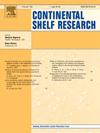泥沙输运过程在近海沙浪形成中的作用
IF 2.2
3区 地球科学
Q2 OCEANOGRAPHY
引用次数: 0
摘要
沙波是一种分布在世界各地沙质浅海床上的大尺度动态床型,对近海结构构成直接威胁,因此迫切需要在年代际尺度上预测相关的床位动力学。数值模型可以帮助我们理解和预测沙波动力学,但在保存沙波形状方面存在困难。利用基于过程的Delft3D柔性网格模型,我们发现泥沙输沙公式的选择对沙波形状的稳定性有显著影响。广泛使用的Van Rijn(1993)泥沙输运公式预测了相对较高的河床输运率,从而提出了对更主要的斜坡诱导输运的需求。模拟结果表明,Van Rijn(2007)公式预测了相对较低的输运率,从而允许较低的床坡引起的输运,能够更好地保持沙波的陡坡,同时限制沙波的增长。通过在我们的模型评估中考虑各种形状特征,对物理过程参数化变化的改进和不利影响有了更多的了解。这些特征表明,只有在坡面输运不占优势的情况下,波峰水平是稳定的,而波谷水平随时间缓慢下降。这表明,局部过程对沙波的增长起着限制作用,而斜坡引起的输运的重要性在以前的工作中被夸大了。与两个对比沙波场的水深场数据相比,采用经过调整的、非升级的设置,该模型可以很好地代表多年时间尺度上的沙波演变。本文章由计算机程序翻译,如有差异,请以英文原文为准。
The role of sediment transport processes in shaping offshore sand waves
Sand waves, large scale dynamic bedforms, which are found on sandy, shallow seabeds worldwide, present an immediate risk to offshore structures, raising a pressing need for predicting related bed level dynamics on decadal timescales. Numerical models can help us understand and predict sand wave dynamics, but have shown difficulties with preserving sand wave shapes. Using the process-based Delft3D Flexible Mesh model, we have found that the choice of sediment transport formulation has a significant effect on the stability of sand wave shapes. The widely used Van Rijn (1993) sediment transport formulation predicts relatively high bed load transport rates, thereby raising a need for more dominant slope-induced transport. The simulations revealed that the Van Rijn (2007) formulation, which predicts relatively lower transport rates, and thus allows for lower bed slope-induced transports, is better capable of preserving the steep slopes of sand waves, while limiting sand wave growth. By considering various shape characteristics in our model assessment, more insight is gained about the improvements as well as adverse effects of changes in the parameterization of physical processes. These characteristics show that only with the less dominant bed slope-induced transport the crest levels are stable, while trough levels still lower slowly over time. This indicates that local processes are responsible for limiting the growth of sand waves and the importance of slope-induced transport has been overstated in previous works. With the adapted, non-upscaled set-up, the evolution of sand waves over multiyear timescales is represented well in the model compared to bathymetric field data for two contrasting sand wave field sites.
求助全文
通过发布文献求助,成功后即可免费获取论文全文。
去求助
来源期刊

Continental Shelf Research
地学-海洋学
CiteScore
4.30
自引率
4.30%
发文量
136
审稿时长
6.1 months
期刊介绍:
Continental Shelf Research publishes articles dealing with the biological, chemical, geological and physical oceanography of the shallow marine environment, from coastal and estuarine waters out to the shelf break. The continental shelf is a critical environment within the land-ocean continuum, and many processes, functions and problems in the continental shelf are driven by terrestrial inputs transported through the rivers and estuaries to the coastal and continental shelf areas. Manuscripts that deal with these topics must make a clear link to the continental shelf. Examples of research areas include:
Physical sedimentology and geomorphology
Geochemistry of the coastal ocean (inorganic and organic)
Marine environment and anthropogenic effects
Interaction of physical dynamics with natural and manmade shoreline features
Benthic, phytoplankton and zooplankton ecology
Coastal water and sediment quality, and ecosystem health
Benthic-pelagic coupling (physical and biogeochemical)
Interactions between physical dynamics (waves, currents, mixing, etc.) and biogeochemical cycles
Estuarine, coastal and shelf sea modelling and process studies.
 求助内容:
求助内容: 应助结果提醒方式:
应助结果提醒方式:


